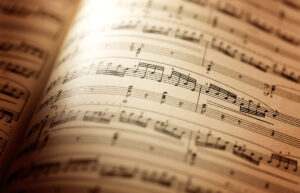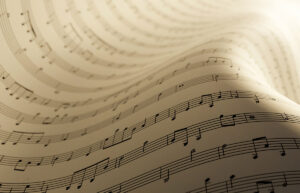Rhythm in Music: The Heartbeat of Sound

Every beat, pause, and groove tells a story that resonates with the heart and soul.
In this article, I unravel the essence of “rhythm,” the heartbeat that pulsates through every musical creation. Because understanding its pivotal role in shaping musical compositions is critical is music composition, I explain the elements that mold rhythm and explore its diverse types. Rhythm not only sets the mood but also enhances melodies while providing a structural backbone to compositions.
Rhythm profoundly affects emotions and movements. I detail ways to train yourself and enhance your sense of rhythm in music to unlock an emotive nonsyllabic language to craft captivating musical pieces.
Welcome to TheDemoStop, now join the community!
Connect with artists, fans and producers around the world.
What is rhythm in music?
In the strictest of terms, “rhythm is an ordered recurrent alternation of strong and weak elements in the flow of sound and silence in speech.” However, this definition is too technical, and neither a layman nor a seasoned musician would make no head or tail of the explanation.
To simplify, rhythm is the heartbeat of music, the pulse that gives a song its groove and vitality. In simple terms, it’s the pattern of sounds and pauses in music that lends a sense of structure to a composition. It’s what makes your foot tap and your body sway with a song.
Rhythm acts as the road map, guiding you through the musical landscape. It’s made up of elements that work together to create a musical journey – beats, tempo, and meter.
A set rhythm organizes musical elements, establishing a tempo and providing the foundation for melody and harmony. Rhythm can be created through various instruments, vocals, or even by clapping, tapping, or drumming. Rhythm sets the pace, groove, and flow of a musical piece. Rhythm serves as the heartbeat of a song, dictating the tempo and providing the framework for aligning melodies and harmonies.
Rhythm encompasses the arrangement of notes in time, guiding the listener through the musical journey, evoking emotions, and encouraging physical responses, such as tapping feet or dancing. It’s the organized sequence of sound and silence that gives music its dynamic and engaging quality.
Understanding rhythm is crucial for musicians of all levels. Whether you’re a budding drummer, a guitarist, or a singer, having a solid grasp of rhythm enhances your musicality and makes playing with other people harmonious. Mastering rhythm is fundamental for musicians as it allows them to create cohesive, compelling compositions that resonate with listeners on a deep level.
Why is rhythm important in music?
Rhythmic elements–the beat, tempo, and patterns–that provide structure and coherence to melodies and harmonies.
Can you imagine a song without a rhythm? It would be so dissonant that it would feel disjointed and fail to captivate listeners. Rhythm infuses life into music, making listeners sway, tap their feet, or dance along.
Whether it’s the steady drumming in rock, the syncopation in jazz, or the thumping bass in electronic music, rhythm gives music its vitality and ensures it resonates deep within us. In essence, it’s the pulse that makes us feel and connect with the soul of the music.
Elements of rhythm in music
Here are key elements that constitute rhythm in music:
Beats
The feet move to the beat of the music.
Beats form the basic unit of time in music. In the simplest example of a beat, think of a metronome providing a beep after certain intervals. In a simple 4/4 time signature, a set of four beeps of metronome constitute a beat. In a musical composition, four snare drum strikes become a beat. With musical exposition, snare drums can be replaced with tom-tom hits, bass drum kick, or a slap of the cymbal to add variation to the music.
Pulses
The musical elements between the beats are pulses. These elements can be varied and constitute most of the rhythm. Pulses are the underlying subdivisions within a beat. They give a sense of flow to the rhythm.
Tempo
Tempo refers to the speed at which the beats occur. Think again of the metronome. The intervals between each beep is the tempo. Based on the composition of the song, the beat can vary considerably. In most musical notations, the tempo is set to 72 beats per minute (bpm). For faster songs, an upbeat tempo of 120 songs or higher is the norm. A slow song may demand a slow tempo of 40 bpm. The tempo dictates how fast or slow the beats and pulses unfold, influencing the feel of the music.
Time signature
Without time signatures, Beethoven would have never been able to create the wonderful symphonies he is renowned for.
The time signature is the notation indicating how many notes (or beats) are set in a particular time. In other words, the time signature is a measure of music and defines the number of beats in each measure and the type of note that it has in one beat. Time signatures can either be simple or compound. A simple time signature is 4/4, having 4 notes in a bar (one segment of time in a musical sheet). An example of a compound time signature is ¾. In a time signature, the lower numeral is always multiple of 2. The upper numeral indicates the number of notes or beats in a bar.
Accents
Accents are emphasized beats or notes within a measure. They add emphasis, creating dynamics and shaping the musical phrases. Advanced players deftly use accents to add nuance to their musical style.
Meter
A meter organizes beats into regular patterns, creating a sense of structure. It gives structure to the rhythm, often in patterns.
Syncopation
Syncopation occurs when the accent is placed on weaker beats or offbeats, disrupting the regular rhythm. It adds a sense of unpredictability and can make the music more dynamic and exciting.
Phrase
Phrase plays an essential role in creating the rhythm of music. They are building blocks that musicians use to craft the beats, melodies, and harmonies that captivate our ears. A phrase is like a musical sentence, made up of smaller parts, each contributing its unique flavor to the overall rhythm.
Welcome to TheDemoStop, now join the community!
Connect with artists, fans and producers around the world.
How do you know the rhythm of a song?
Understanding the rhythm of a song involves feeling and identifying the pattern of beats, tempo, and musical accents within the music. You can discern the rhythm by listening attentively, noticing recurring patterns, tapping your foot or clapping your hands in time with the music, and recognizing the stressed beats or downbeats.
Additionally, paying attention to the song’s tempo, the pace or speed of the beats, and noting any syncopation or irregular rhythms further helps in comprehension and connecting with the musical rhythm.
Is rhythm in music always fixed?
Rhythm in music isn’t always fixed. While certain musical compositions have a predetermined rhythm, others offer flexibility. Improvisational music styles, such as jazz or some forms of world music, allow for dynamic and fluid rhythms, giving musicians the freedom to explore various tempos and rhythmic patterns.
Additionally, contemporary genres like electronic music often utilize technology to create adjustable and evolving rhythms, demonstrating that rhythm in music can indeed be malleable and adaptable.
How does rhythm affect music?
Rhythm stands as the heartbeat of music, influencing its soul and shaping its essence. It serves as the driving force that creates patterns, establishes tempo, and generates the energy that defines different musical genres. By manipulating the pace, duration, and emphasis of musical notes, rhythm infuses music with its vitality, making it captivating, dynamic, and engaging for listeners across various cultures and eras.
The interplay of rhythm with melody and harmony creates a cohesive structure, providing the foundation upon which musicians craft melodies, harmonies, and intricate compositions that resonate with our emotions and experiences.
Types of rhythms in music
Each type of rhythm contributes its own unique feel and style to musical compositions, influencing the pace, mood, and movement of the music. Here’s a list detailing different types of rhythms in music:
Random rhythm
This type of rhythm lacks a predictable pattern or structure and is characterized by irregular betas and intervals. This rhythm pulsates with a blend of patterns that defy traditional norms, sparking creativity and a sense of freedom within musical compositions.
Regular rhythm
Regular rhythm maintains a consistent and predictable pattern of betas, creating a stable and easily recognizable rhythm. This consistency in rhythm provides a foundational structure, allowing listeners to anticipate and engage with music or activity more easily.
Alternating rhythm
Alternating rhythm involves a repetitive sequence of two different note values, creating a dynamic and shifting pattern. This technique creates an engaging and diverse musical experience, adding depth and intrigue to compositions.
Additive rhythm
Additive rhythm involves the addition of smaller, irregular note values to create a larger and more complex rhythmic pattern. It’s a method used across various musical genres to generate compelling and multifaceted rhythmic compositions, enriching the depth and complexity of musical pieces.
Harmonic rhythm
Harmonic rhythm relates to the pace at which chords change with a musical piece, influencing the overall flow and structure. This rhythm often influences the emotional and structural aspects of a musical composition, creating a sense of coherence, flow, and tension within the music.
Flowing rhythm
Flowing rhythm embodies a smooth and continuous flow of beats, often characterized by seamless transitions between notes. This rhythmic expression captivates listeners with its natural and effortless progression, evoking emotions and fostering a sense of unity within a musical piece.
Progressive rhythm
Progressive rhythm involves a gradual or incremental change in the rhythmic pattern, evolving and building upon itself throughout the musical composition. It embraces innovation, pushing boundaries within the musical landscape, and allows for diverse expressions across various genres.
Welcome to TheDemoStop, now join the community!
Connect with artists, fans and producers around the world.
10 Tips to improve your rhythm
Enhancing your sense of rhythm can significantly elevate your musical performance. Here are ten valuable tips to help you fine-tune your rhythmic skills
1. Practice rhythms
Set aside time daily to practice various rhythms. Start slow and gradually increase the tempo as you become more proficient. Practicing is key to unlocking your talent. You have to practice diligently to master the rhythm.
2. Move to the beat
Incorporate movement while practicing rhythms. It could be tapping your foot, or even dancing to the rhythm of the music. Be attuned to the rhythm. Twirl and sway with the music, all the while intoning the rhythm.
3. Get familiar with the song
The power of repetition is thoroughly understated in music. Listen to the song repeatedly to internalize its tempo and feel. Allow your mind to be rewired and internalized by the melody. Lose yourself in the rhythm.
4. Be confident, even if it’s not perfect
To err is human. Don’t be discouraged by mistakes. Confidence helps in maintaining rhythm, even during slips. Music maestros failed miserably hundreds of times, but they picked up their instruments and determinedly set again to be on the right path. No musician can play to the beat 100 percent. Occasionally, you may lag, sometimes you may lead.
5. Use a metronome
A metronome is one of the most powerful for practicing rhythm and helps you to stay in time and improve consistency. Set the metronome to various tempos and try double looping or slowing your music to the sound of the ticks emanating from the device.
6. Divide the beats and practice
Complex rhythms have to be broken down into smaller parts for regular practice. These sections have to be practiced till you get them right on the tempo. First play them separately and then combine them to obtain the piece.
7. Play before or after the beat
Explore how you sound if you play slightly ahead or behind the beat. This experimentation can help in developing a deeper understanding of timing and make you a complete musician. Numerous musical hits were obtained through subtle variations in timings.
8. Use words to learn common rhythm patterns
Verbalize rhythms using words or syllables to comprehend their structure better. You can try humming or thumping on every note at a particular tempo. Remember the Queen’s iconic “We Will Rock You.” You can actually vocalize the thumps. Try something similar. Who knows, you can stumble into something just as remarkable and belt out a rollicker of a rhythm pattern that can become the anthem of your generation.
9. Use resources: apps, drum machines, and backing tracks
In the digital era, numerous applications have mushroomed to help improve your music. Utilize technology like apps or drum machines to practice different rhythms. Backing tracks can also assist in keeping track of time. Record, playback, play around to get the sound right.
10. Know when to take a break
While practice is important, ensure that you do not fall into the trap of mental fatigue. Taking breaks allows you to refresh your mind and body and aids in better rhythm development. Just as cramming one day before examinations does not help, you have to time your practice sessions and include regular breaks for mental recovery.
Conclusion
Understanding the rhythm in music is akin to comprehending the heartbeat of the music; it’s the foundation that breathes life into musical compositions. The following are key takeaways that illuminate the essence of rhythm in the world of music:
- What is rhythm? Rhythm is the pulse of music, comprising elements like beats, tempo, and meter, creating patterns of sound and silence that shape musical movements.
- Why is rhythm important in music? Rhythm isn’t just background noise; it’s the essence of music itself. It sets the mood, provides structure, and infuses life into melodies, making them memorable.
- Elements of rhythm in music: Beats, pulses, tempo, time signature, meter, accents, phrases, and syncopation form the foundational elements that constitute rhythm.
- How do you know the rhythm of a song?: Listen attentively, tap along, recognize stressed beats, and understand the tempo and musical accents.
- Is rhythm in music always fixed?: No, certain music, such as jazz, allows flexibility in rhythm, enabling dynamic and fluid rhythmic patterns.
- How rhythm affects music: Rhythm is the unseen force that shapes music’s essence, influencing emotions and connecting listeners with its soulful essence.
- Types of rhythm in music: From random rhythms to flowing and progressive ones, each type adds its unique touch, influencing the music’s pace, mood, and movement.
- 10 ways to improve your rhythm: Practice regularly, move with the beat, get familiar with songs, stay confident, use a metronome, break down complex rhythms, experiment with timing, verbalize rhythms, utilize resources, and take breaks when needed.
FAQs
What is rhythm in music?
Rhythm in music is the heartbeat, the pulse that gives a song its groove and structure. It’s the pattern of sounds and silences that creates movement, guiding listeners through the musical journey and making them tap their feet or sway in time with the music. Essentially, it’s what makes music lively, engaging, and captivating.
Why is rhythm important in music?
Rhythm in music is crucial as it establishes the framework and groove of a song, setting its pace and flow. It forms the backbone of musical structure, guiding listeners through emotional journeys and providing cohesion to melodies and harmonies. Rhythm adds depth, emotion, and a sense of movement, making music engaging and memorable.
What are the elements of rhythm in music?
In music, rhythm comprises various elements that collectively create its pulse and structure. Some fundamental elements of rhythm include beats, tempo, time signature, meter, accents, and syncopation, all working together to craft the heartbeat of a musical piece.
How to improve rhythm in music?
Improving rhythm in music involves practicing with a metronome to enhance timing, breaking down complex rhythms into smaller segments for easier mastery, and regularly counting along with music to develop a better understanding of beats and patterns. It’s also beneficial to record practice sessions and play them back for self-assessment and consistent training of the ears to different rhythms across various music genres.
What are the types of rhythm?
There are several types of rhythm in music. The five primary types include regular rhythm, irregular rhythm, flowing rhythm, progressive rhythm, and random rhythm. Each type contributes its own distinct style and feel to musical compositions, influencing the pace, mood, and movement of music.
How rhythm affects music?
Rhythm plays a pivotal role in music, acting as its heartbeat. It sets the pace, creating a structured framework that shapes the overall feel and flow of a music piece. It’s the backbone that unites the instruments and vocals, dictating the pace and energy, making each musical piece unique and compelling.
How do you know the rhythm of a song?
Identifying the rhythm of a song involves recognizing its beat and pattern. You can tap your foot, nod your head, or clap your hands in time with the music to catch its rhythm. Additionally, paying attention to the regularity of the musical notes or lyrics can guide you in recognizing and following the song’s rhythm.
Is rhythm in music always fixed?
No, rhythm in music isn’t always fixed. It can vary based on the style, genre, and individual interpretation. Rhythm is often flexible, allowing musicians to adjust tempo, timing, and emphasis, offering a unique touch to each performance.
Is rhythm the most important element in music?
Rhythm is undoubtedly a fundamental aspect of music. While essential, it’s just one of many crucial elements like melody, harmony, and dynamics. Rhythm provides structure and groove, but it’s the blend of all these components that creates the magic in music, making each element equally important in crafting an engaging musical experience.































































